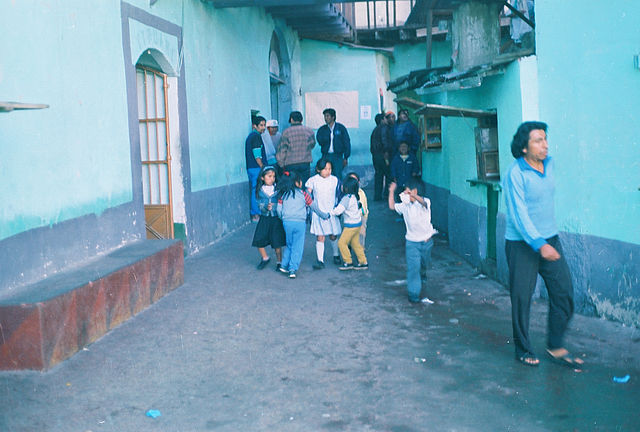New Kids on the Block

The image above is from a La Paz, Bolivia. There are five children in the center, playing something like Ring Around the Rosie in the alley. Two other children are also in the alleyway, are as a handful of adults. But it isn’t from a street — at least not a typical one. To start, at least one of the men, if not all of them, are felons. We know that because those men are in prison. With their kids.
The picture comes from San Pedro prison, the largest in Bolivia’s de facto capital. The prison is home to 1,500 inmates but isn’t like a lot of other institutions. The corrections system treats San Pedro as its own society — one which operates in a roughly self-sufficient manner. There are no prison guards, and despite this fact, it’s not a lawless frontier. As Oddity Central explains, inmates have created a “system of laws and rules” and the enforcement mechanisms to deal with rule breakers. It’s a crude and unpleasant system — there are more “accidental” deaths than one would otherwise see — but probably no more crude nor unpleasant than traditional prison systems.
And the prisoners do not live alone. Their families and children are welcome to join them, living as if they were free, mostly. Families buy cells from recently released inmates (the high-end cells can run $1,000 to $1,500) and can outfit them with amenities from the outside world; some have cable television and private restrooms, according to Wikipedia. Inmates can’t leave, of course, but wives and children are allowed to come and go for the most part. Not that they have to very often — San Pedro is a town in its own right. As the BBC reported, “once you pass the thick walls and the security gates, any resemblance to a normal jail disappears: there are children playing, market stalls, restaurants, hairdressers and even a hotel. It looks more like the streets of El Alto, Bolivia’s poorest neighborhood that sprawls on the outskirts of La Paz, than a prison.”
San Pedro is an experiment of sorts, unique among institutions of its type. But while San Pedro feels unlike any other prison, one notable feature isn’t unique to it at all. In many institutions in Bolivia, children often live with their incarcerated parents.
Under Bolivian law, per the BBC, “children under six years are allowed to stay in their parents’ cells.” The children above aren’t that young — as the BBC further explains, children often remain with their parents (typically with an incarcerated mother) even after they reach that age milestone. (San Pedro is slightly different. Families all live under the same roof, as noted above, older children are welcome to be part of the prison.) After all, if mom’s in prison, where is a six year old to go? The prison system often turns a blind eye toward older children living in those conditions, except to make sure that in general, they’re cared after.
In total, there are roughly 1,200 to 1,500 children living with their parents in Bolivian prisons. (About 200 of those live at San Pedro.) Many of these children were born in the prison and have never been part of the greater society. The practice is, of course, controversial, with proponents arguing that the children would otherwise be left to fend for themselves (or with inadequate guardianship) in some of Bolivia’s poorer and rougher neighborhoods. Opponents of the practice, in effect, argue that neither poverty nor prison is a fair outcome and society should find a third option. While that hope is laudable, Bolivia has yet to find a solution.
Bonus Fact: According to a 2010 report by the Pew Charitable Trust (click here and hit the “more” link), 1 in 28 children in the United States have “a parent behind bars.”
From the Archives: Pedaling to Freedom: Another prison experiment. Less massive, though.
Related: “Orange is the New Black: My Year in Women’s Prison,” by Piper Kerman. The book which inspired the Netflix TV show of the almost-same name.
